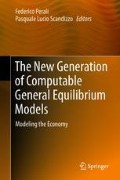Abstract
This chapter analyzes the variations in industrial structure induced by income-sensitive patterns of final consumption, and how these changes can be captured by a multi-sector numerical model with a flexible demand system. We focus, in particular, on the estimation of parameters for an AIDADS (An Implicitly, Directly Additive Demand System) specification. We then test the latter by inserting it in the ENVISAGE global general equilibrium dynamic model, which is run under the SSP2 scenario from 2011 to 2050. It is found that time-varying income elasticity can generate sizable variations in the industrial structure. This finding has important practical implications, particularly when structural models are applied at a medium and long term horizon.
Access this chapter
Tax calculation will be finalised at checkout
Purchases are for personal use only
Notes
- 1.
Technical details about the specific algorithm and software are available on request.
- 2.
Labor productivity growth is assumed to be smaller for Services and greater for Manufacturing industries.
- 3.
Parameters of the AIDADS system were adjusted to fit the different industrial classification in ENVISAGE.
References
Buera, F. J., Kaboski, J. P., & Zhao, M. Q. (2013). The Rise of Services: the Role of Skills, Scale, and Female Labor Supply. NBER Working Paper 19372.
Caron, J., & Markusen, J. R. (2014). International trade puzzles: A solution linking production and preferences. The Quarterly Journal of Economics, 1501–1552.
Comin, D. A., Lashkari, D., & Mestieri, M. (2015). Structural change with long-run income and price effects. National Bureau of Economic Research Working Paper Series No. 21595.
Cranfield, J. A. L. (1999). Aggregating non-linear consumer demands: A maximum entropy approach. Ph.D. thesis, Purdue University.
Cranfield, J. A. L., Eales, J. S., Hertel, T. W., & Preckel, P. V. (2003). Model selection when estimating and predicting consumer demands using international, cross section data. Empirical Economics, 28, 353–364.
Fieler, A. C. (2011). Nonhomotheticity and Bilateral Trade: Evidence and a Quantitative Explanation. Econometrica, 79(4), 1069–1101.
Gohin, A. (2005). The specification of price and income elasticities in computable general equilibrium models: An application of latent separability. Economic Modelling, 22(5), 905–925.
Golub, A., & Hertel, T. W. (2008). Global Economic Integration and Land Use Change. Journal of Economic Integration, 23(3), 463–488.
Harberger, A. C. (1998). A Vision of the Growth Process. The American Economic Review, 88(1), 1–32.
ICP. (2015). Purchasing Power Parities and Real Expenditures of World Economics: A Comprehensive Report of the 2011 International Comparison Program. Washington, D.C.: World Bank.
Matsuyama, K. (2002). The Rise of Mass Consumption Societies. Journal of Political Economy, 110(5), 1035–1070.
Matsuyama, K. (2016). The Generalized Engel’s Law. In Search for A New Framework: Public lecture, Canon Institute for Global Studies.
Powell, A. A., Mclaren, K. R., Pearson, K. R., & Rimmer, M. T. (2002). Cobb-Douglas Utility - Eventually! CoPS Working Paper No. IP80.
Rimmer, M. T., & Powell, A. A. (1992). Demand Patterns across the Development Spectrum: Estimates for the AIDADS System. CoPS Working Paper No. OP75.
van der Mensbrugghe, D. (2017). The environmental impact and sustainability applied general equilibrium (ENVISAGE) model: Version 10.01. Technical report, The Center for Global Trade Analysis, Purdue University.
Yu, W., Hertel, T., Preckel, P., & Eales, J. (2004). Projecting world food demand using alternative demand systems. Economic Modelling, 18(21), 205–236.
Yu, W., Hertel, T. W., Eales, J. S., Preckel, P. V. (2000). Integrating the AIDADS Demand System into the GTAP Model. In 3rd Annual Conference on Global Economic Analysis.
Author information
Authors and Affiliations
Corresponding author
Editor information
Editors and Affiliations
Rights and permissions
Copyright information
© 2018 Springer International Publishing AG, part of Springer Nature
About this chapter
Cite this chapter
Roson, R., van der Mensbrugghe, D. (2018). Demand-Driven Structural Change in Applied General Equilibrium Models. In: Perali, F., Scandizzo, P. (eds) The New Generation of Computable General Equilibrium Models. Springer, Cham. https://doi.org/10.1007/978-3-319-58533-8_2
Download citation
DOI: https://doi.org/10.1007/978-3-319-58533-8_2
Published:
Publisher Name: Springer, Cham
Print ISBN: 978-3-319-58532-1
Online ISBN: 978-3-319-58533-8
eBook Packages: Economics and FinanceEconomics and Finance (R0)

